Entropic engines and retooled appliances: Michel de Broin and the technological unconscious, Daniel Sherer
Musée d’art contemporain de Montréal
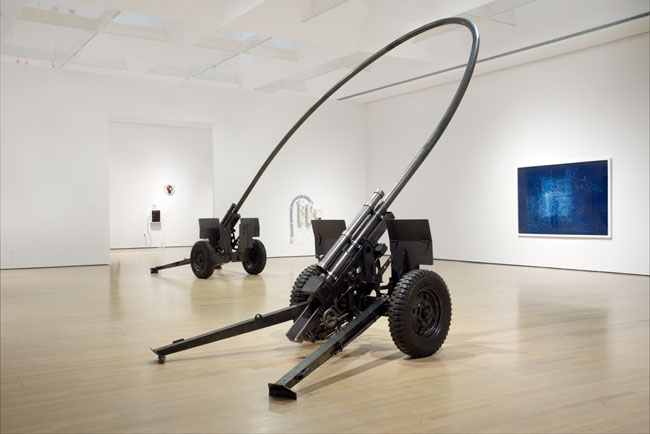
Blowback, 2013
The art of Michel de Broin centres on the paradoxical refunctionalization of utilitarian objects, mechanical devices, architecture and urban infrastructure. Ranging across a broad spectrum, it opens new perspectives on the multiple technical systems and forms of mediation that affect our lives, often in intangible ways. Over the course of more than two decades, de Broin has produced an enigmatic and compelling body of work that defamiliarizes the sites, energy flows and technologies of daily life. Transforming a representative sample of the objects of capitalist production so they occupy a range of functions from the ludic to the erotic to the blandly impersonal, his work charts a journey through what might be called the technological unconscious. Paired refrigerators send out long extensions, making us witness a cold, yet undeniably intense form of romance; cannons grow barrels connected by a continuous parabola; streetlamps are cut by a chainsaw and harvested like firewood; bicycles have no engines but still emit exhaust; cars are driven by pedal power; curving stairways form an unbroken loop: all of these hybrids populate de Broin’s continually retooled technological environment. What emerges from these transformations is a parallel universe that is strangely different than, yet in many ways uncannily similar to, our own. In this world the object is liberated from codified uses and established modes of signification, yielding unexpected exchanges, improbable detours and delightfully skewed solutions to problems whose existence was unsuspected.
Throughout his trajectory, de Broin has exhibited a unique propensity to think freely about technology, reinventing basic modalities of function. Bringing together disparate frames of reference, he disrupts the horizon of expectations engaged by the network of objects, commodities and resources that are usually taken for granted. In general, his approach gives rise to small-scale epiphanies that redraw the boundaries between the familiar and the inconceivable: in this way he opens up a space for the deployment of alterna-tive technologies that assume new semantic and emotive charges along with their altered functions.
Two antithetical impulses drive de Broin’s practice. On the one hand, there are stochastic processes of indeterminism that result in random collisions between systems and in the primacy of non-systemic features; on the other hand, one confronts the overdetermination and collision of levels of meaning which derive from these processes. Both enter into dialectic with ordinary language and with “language games.” The novel relationships that result are signalled not only by such titles as L’Abîme de la Liberté (an inverted sculpture modeled on the Statue of Liberty), Keep On Smoking (a bicycle that emits exhaust fumes) and Blowback (cannons in a continuous loop), but also in the dialogue between title and object. Since, as with language, the use of the object is bound up with its meaning, in de Broin’s universe, the actualization of dysfunctionalities and alternative paths of functionality gives rise to a dense knot of meanings.
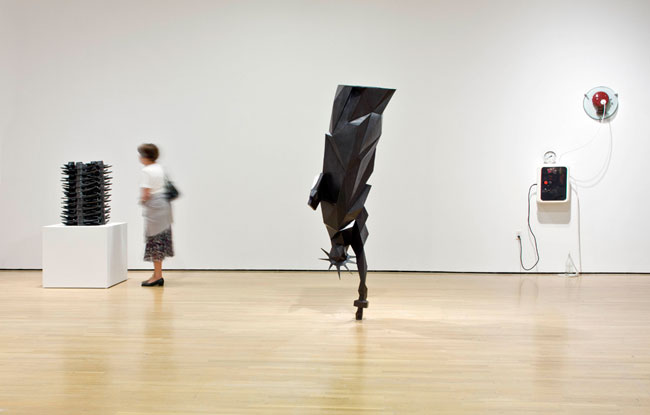
Installation view
POLITICS OF THE MACHINE
In balancing entropy against system in singular ways, de Broin’s work positions itself as Conceptual and anti-Conceptual all at once. It does this by rejecting those forms of propositional logic which provide the basis of Conceptual practice in favour of multiple logics — chief among which is the devolutionary logic of entropy — that work against each other. These disclose latent contradic-tions that arise between technology and its sociopolitical conditions, as well as hidden forces that link them. In this as in other respects his work presents certain commonalities with tendencies and critical readings of machine art that date back to the mid to late 1960s. As Pontius Hulten has pointed out, the term machine designates an object that has a practical purpose, a device that replaces or extends man’s own forces. Hulten observed that the word itself has the same root as “might.” In light of this observation, de Broin’s system of metaphors (in Blumenberg’s terms, a metaphorology) comparing political power to machinic power, in addition to having critical actuality, turns out to have a long genealogy(1).
Here, among many other works, Blowback stands out, though given its implicit political dimension it should also be paired with L’Abîme de la Liberté: if the first turns weaponry against itself as a potent metaphor for the lethal turning back on their sponsors of the Taliban who were initially supported financially and militarily by the CIA — a reading supported by the title which refers specifically to this phenomenon — the second literally turns the Statue of Liberty upside down to express in the most concrete terms what happened to the U.S.A., purportedly the freest democracy in the world, when liberties were undermined in the hysteria following 9/11 along with the proliferation of abuses, legal, political and ethical in the widest sense, from the Patriot Act onwards.
Another work with a latent political charge is Cut in the Dark, in which a streetlamp is cut down with a power saw. This action is recorded in a dim video that at the end goes entirely black, given the extinguishing of the only source of illumination. In addition to transposing the technology of the urban infrastructure into an ironic naturalism metaphorically identifying the lamp with a tree and its destruction with the harvesting of wood (the cut metal cylinders of the streetlamp shaft are gathered like hollow pieces of firewood in a later work, Pile), this piece provides a nuanced figure of political revolution. This much is clear from the work of Wolfgang Schivelbusch, whose history of streetlighting, Disenchanted Night, shows that the collective destruction of streetlights first occurred in 1789 in Paris, and then accompanied every major revolution from 1832 to 1848 as a leitmotiv of political upheaval and a spur to revolutionary action(2). To destroy a streetlamp has political implications for the control of urban space outside of the usual dominion of the state authorities; at the same time, it is an act of pure dépense, a joyous form of rebellion. This work can thus be said to reactivate collective memories of urban insurrection, here represented in the most minimal terms, through the action of a single individual.
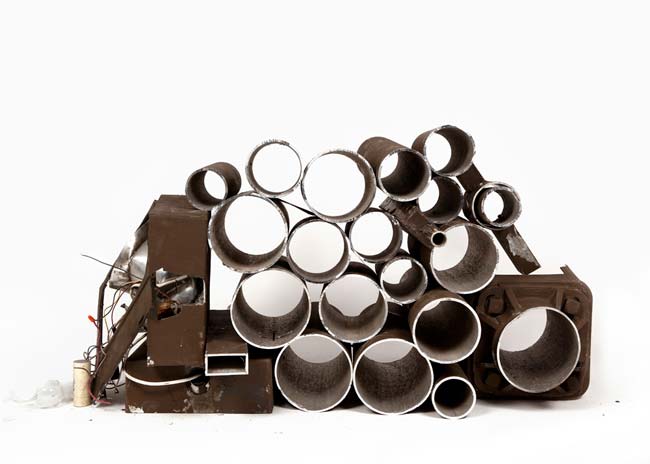
Pile, 2010
CHANCE ENCOUNTERS
Starting from a simple conceptual premise, physical juxtaposition, or found object, de Broin generates unexpected levels of complexity. One of the best examples of this process is Drunken Brawl, which elicits a singular form of tension in the video recording of random movements of three beer cans pushed about by the wind above a ventilation grate near the Gare d’Austerlitz in Paris. The title establishes a resonance with Marcel Duchamp’s Bagarre d’Austerlitz (The Brawl at Austerlitz) of 1921. Reading as a mysterious dance that follows its own occult rhythm, the interaction of the metal cans assumes an uncanny life of its own. Here one can speak not only of found objects but more cogently of found gestures.
But not only of these: for as in the case of this particular work, his art in general is polyvalent, owing to disparities, incongruities and redundancies that emerge when contingency and causality interact, overlap and enter into ambiguous relationships. This makes it difficult, if not impossible, to distinguish between accidental and determined phenomena. A recent example of this is Braking Matter, in which pieces of Play-Doh of different colours are thrown randomly on the gallery wall to form a constellation. We are thus confronted by an alternative version of action painting without a frame, open to the architecture of the gallery as a scatter piece adhering to the wall surface. In works such as these, which presuppose a rapid increase in randomness, what emerges most clearly is a sudden recognition of the materiality of the signifier. Here the question of identifying the signified is less important than the enactment of visual signification itself.
This alternation between contingency and necessity, one of the chief subjects of de Broin’s artistic inquiry, frequently appears in the context of recursive systems. Throughout his exploration of the latent potentials of the object, his embrace of circularity implies not only a folding back of techne onto itself but also a recurrent interplay between these feedback loops and atavisms, irregularities and discrepancies of all kinds. This leads to the fundamental asymmetry between cause and effect that is a hallmark of his oeuvre.
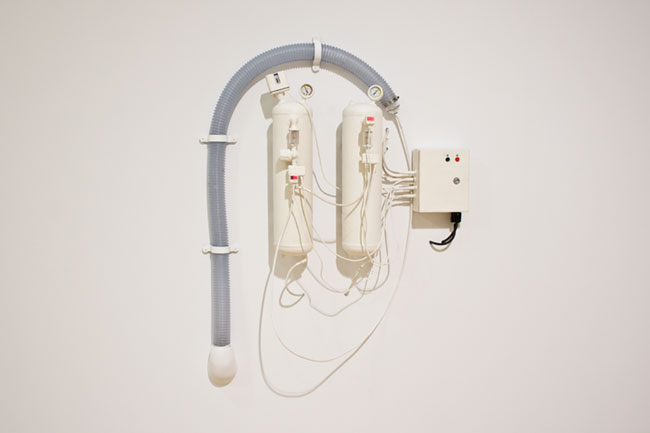
Lost Object, 2002-2013
DOWNWARD SPIRALS, DANGEROUS PROXIMITIES
This asymmetry is exemplified by de Broin’s unanticipated transformations of everyday appliances. In Bleed, a power drill spouts water; in Étant donnés(3), an overturned sink spurts water and flames from its spigot, lending new meaning to the term “energy sink,” which is often used as a metaphor for entropy; in Fuite, water pours incongruously out of an electrical outlet; in The Great Encounter, refrigerators interpenetrate; the multi-coloured biomorphic sculpture Dead Star is made out of hundreds of dead batteries; in Réparations, a bicycle pump powers small bottle rockets with a mixture of hydraulic and air pressure. In a different register, this downward and dangerous movement is apparent in the series of pieces based on self-defeating transformations of military hardware, for example Trompe, a rifle bent over into a spiral so it would shoot “infinitely” within itself if fired, and Blowback, in which the paired cannons’ barrels loop into each other. This last work is particularly significant, as it forms a continuous, potentially self-destructive, yet visually spectacular and spatially ample circuit that serves as a metaphor for political involution, dramatizing the way certain systems, both technical and ideological, are their own undoing.
A key aspect of de Broin’s approach is the thematization of risk. This can take the form of dangerous proximities of matter and energy normally kept apart (i.e., electricity and water, fire and water) or, as already seen, of weapons whose lethal force is potentially turned against itself. Emphasizing the fact that of all major modern economic systems, capitalism is the one most clearly predicated on risk, his work can be construed as an entropic allegory of an economic order which is bound to run down eventually. The theme of risk is also present in the flimsiness of many manufactured objects, a characteristic that rather quaintly used to be called “planned obsolescence.” De Broin uses this idea to expose the precariousness of modern industrial techne. A particularly vivid instance of this is Shared Propulsion Car, in which the engine of a 1984 Buick Regal is gutted and replaced by four sets of pedals. Pedalling this oversized luxury car indicates that de Broin is concerned primarily with foregrounding a logic of dépense in Bataille’s sense, presented as both an archaic and a recurrent dimension of modern technology.
Given these premises, it is not surprising that entropy has been seen as an essential feature of de Broin’s art. Yet unlike normative conceptions of entropy, for de Broin entropic loss is a way to exceed the limit of the system of production. The investing of entropy with positive value is a key reversal in his artistic world: according to its peculiar logic, gain and loss become interchangeable. In this regard, the artistic incline for entropy is linked in some fundamental sense to the space of the political, insofar as entropic process is understood to be a part of the work that freely escapes from the system.
In addition to addressing capitalism’s obsession with energy consumption, de Broin’s work also involves an “archaeology of energetics” that elicits a retrospective glance at the material and ideological origins of current conceptions of technical progress. Indeed, one can argue that this “archaeological” dimension of de Broin’s production, visible in its emphasis on earlier modes of energy use and its fascination with machinic anachronisms, is a way to more fully understand and contextualize his focus on technological paradoxes — for paradoxes of this kind lie at the heart of progressive modernity. As Anson Rabinbach has noted, “The paradoxical relationship between energy and entropy is at the core of the nineteenth-century revolution in modernity: on the one side is a stable and productivist universe of original and indestructible force, on the other an irreversible system of decline and deterioration.(4)” De Broin’s art, in excavating the earlier energy systems beneath the present phase of petrochemical and electric power, places itself squarely within the space of this paradox.
In so doing, de Broin exposes the deeply embedded sets of assumptions that have grown up around modern technology as well as related cycles of expenditure and consumption. In this regard he offers a wry critique of the dynamics of capitalist production incorporating waste, regression and loss into the fabric of its operative presuppositions. Two major sectors of the dynamic functioning of capital are sometimes equated by de Broin’s aesthetic strategy: leisure and waste — that is, time wasted from the point of view of the Protestant work ethic and waste-matter left behind by production processes. Perhaps the best instance of this is Monochrome Bleu, in which a dumpster is transformed into a Jacuzzi. Fusing spaces of refuse and pleasure with potent irony, this piece gives new mean-ing to the catchphrase of urban folklore, “dumpster diving,” an implicit reference which reads as an abject qualification of the high-art citation of the aesthetic preferences of Yves Klein signalled in the title. At a more general level, this work shows that a basic premise of his exploration of the technological unconscious does not reside in those forms of ingenuity that enter into the machinic universe, but rather in other procedures which elicit atavistic returns to earlier stages of technical development.
However one parses its history, it is clear that one of they key objectives of modern art has always been to turn refuse into art. It is not surprising, then, that the real locus of artistic invention in de Broin’s inverted technologization should be found not in the volatilities of the new but rather in obsolete forms of mechanism — aspects of technology that are thrown, as it were, into the dustbin of history — and in ways they can be ingeniously grafted onto the object, effecting new aesthetic metamorphoses. Machinist ideology, thus reworked, is shorn of its imperialistic pretensions, becoming a local affair restricted to diminished, at times even threadbare, human efforts.
While establishing multiple points of contact between the technical and aesthetic realms, de Broin’s approach makes no grand claims about their relationship. In fact, his work moves in a direction that is opposed to any overarching narrative, despite its mobilization of a modified form of spectacle that dismantles tacit assumptions about the technologies that come into play in everyday life.
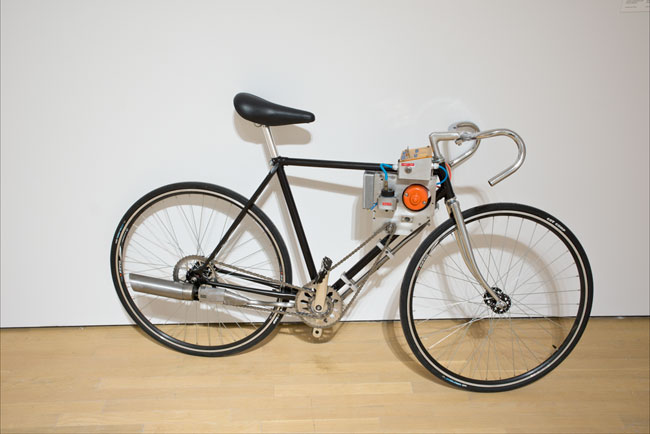
Keep On Smoking, 2005
REVERSE TECHNOLOGIES
Nothing is more simple than the paradoxes that de Broin has chosen to work with. Yet the readings upon which these paradoxes are based are multilayered and complex, dependent as they are upon a metaphorology identifying power, understood as the energies hidden in materials, with the vicissitudes of a political and economic power that traverses and constitutes the social.
Combining a conspicuous economy of means with a restrained exuberance of effects, de Broin’s practice pursues a double movement: on the one hand, it frees the object from codified uses and functions; on the other, it subjects the emancipated object to a new regime of meanings, often direct inversions of generally accepted ones. In this sense one can speak of de Broin’s enigmatic con-traptions as forms of reverse technology, not because they always literally enact the reversal of ordinary technical processes (though they also do that, at times) but because their effects are the reverse of what we usually expect as users of the machine. Thus a power drill becomes a fountain in Bleed; water jets pour forth from an electrical wall outlet in Fuite, leading to the aforementioned uncomfortable proximity of water and electricity.
Strategies based on reverse technology involve a logic of downward compensation in which systems marked by advanced technology are supplanted, even as they are supplemented and reframed by others whose technical level is distinctly lower. This logic implies practices of de-invention and deskilling (in reality, operations attesting to novel forms of artistic invention) converting modern technology into “archaic”conditions of production and functioning, as in Shared Propulsion Car and Keep On Smoking. These works can be seen as pendants since they offer contrasting transformations of vehicles representative of different levels of technical development in a kind of chiasmus: a bicycle that pollutes and a car that has no means of locomotion except the passenger’s feet. In this sense, a quantum leap from the individual to the collective occurs. And this is a key, however oblique, to the significance of the social in de Broin’s output.
When approaching the field in which de Broin’s art is situated, Lewis Mumford’s division of the historical development of civilization into three main technical phases — eotechnic, paleotechnic and neotechnic — assumes particular relevance(5). The first phase is powered by wood, wind and fire; the second by steam and coal; the third is petrochemical, electric and, after that, presumably, electronic, nuclear and digitally mediated. This schema is useful when reading de Broin’s art in light of the idea of transposition and its limits. For a car whose means of propulsion is reduced to bodily exertion reflects a neotechnic reality altered by an eotechnic addition, though in its totality there is a simultaneity, not a displacement, of eotechnic and neotechnic modes. What does this simultaneity reveal about de Broin’s underlying intentions? Among many possible answers, one stands out: that a previous phase of technological development is always present, no matter how far advanced in a neotechnic direction the object in question moves — and, for that matter, no matter how far the actual car can move.
The result is a heterogeneous condition marked by experiential overlay and semantic distortion. These features are particularly evident in the video of Fumée, whose sound track is an Erik Satie Gnossienne played backward as the bicycle is seen making its way through a cemetery, its “para-engine” puffing away, leaving behind trails of wispy smoke. As the bike pushes forward, the sound track moves backward, enacting, through a simultaneity of contraries, the same logic of multiple temporal flows that becomes evident in the collusion of contradictory propulsive mechanisms.
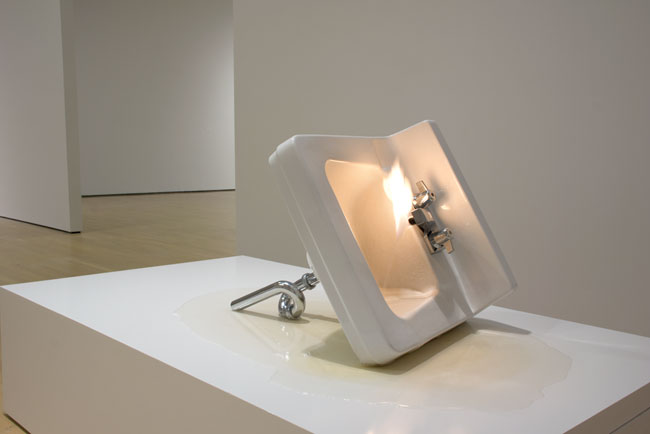
Étant donnés, 2013
PROLIFERATING HOLES
Various functions of the hole characterize de Broin’s artistic universe. On the one hand, the machine or vehicle can have a hole, as in Trou, or even can be a sinkhole or energy sink, as in Étant donnés, thereby becoming a figure of entropic deterioration. On the other hand, it can take the form of a site which winds itself down, dissipating its energies in an inexorable spiral, as in Entrelacement, in which the bicycle must eventually fall over if the tangled path is faithfully followed. Finally, there are instances of a unique reversibility of matter, key to the energetics of the object, as in Irony, a work in which a condom-like rubber tube in a box is forced to move in and out, becoming phallic at one moment and invaginated at the next. The moral of this particular parable of the object is that, under the dynamic conditions the work sets for itself, there is no inside that cannot become an outside. As such, and following its own peculiar logic, this reversible machine is also evocative of an embryological condition, a return to the ground of differentiation of gender and/or sex.
Such a paradoxical synthesis of opposites depends on the identity of a system (the technical apparatus), and hence becomes a figuration of the dialectic, even as it functions as a machinic sign of the operation of the unconscious, which always turns propositions into their opposites. The technological unconscious is thus equated with the dialectic in one of the most powerful instances of defamiliarization in de Broin’s output.
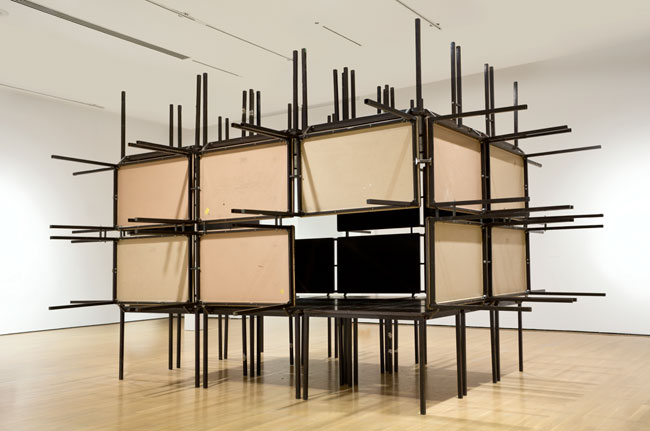
Testudo, 2009
DYSFUNCTIONAL FUNCTIONALITY
By emancipating the object from its customary conceptual moorings through comparable strategies of defamiliarization, retooling and aesthetic transformation, de Broin liberates the viewer from the grip of things we have come to increasingly depend upon, with greater degrees of servitude and ever higher gradients of unconsciousness. Insofar as he delineates an immanent critique of the social implications of technology and its objects, de Broin converts the ideology of needs into a highly textured reality of desires which has as its basis the real of the lack rather than the lack of the real. Navigating this liminal area between the claims of productive rationality and the vagaries of experience, de Broin creates a privileged space for the adventures of the object. Contrary to what the objects that populate this space might appear to be at first glance, they are not faulty replicas of real machines; nor are they actual machines. One way to situate his work in the current cultural and artistic field, and hence to grasp its specificity, is to understand that they are somehow both and neither. His engimatic objects could go on indefinitely with their peculiar dance of functioning and not functioning, or, more precisely, their dysfunctional functionality. On one level, they are allegories of technology and its complex web of social effects; on an-other, they are purely physical puzzles. At the same time, they suggest new possibilities of inquiry, forms of coexistence, and modes of acting on the world.
At the point of juncture between functionality and dysfunctionality, de Broin’s art reveals a blind spot in our technological consciousness. Of the artists of his generation, de Broin is among those who is most acutely aware of this limit. Through his concentration on mechanical breakdowns, feedback loops, hybrid conditions and technical paradoxes, he tries to locate this blind spot by building it, by translating it into constructive and spatial terms. Not so much to overcome it, as to make the observer conscious of its presence, which is at once the presence of an absence and the presence of an impasse, of something that needs to be “negotiated”, whether it is loss, death, stupidity or “society.” This impasse, which is also the way around its own impediment, is what might be called his particular “meta-mechanism”: a self-problematizing device, the royal road out of the problem through the problem, a way of putting the negative (which is never in short supply in human affairs) to work.
Actually the logic is also reversed, since in his work, the effort is often maximal, and the effect is minimal. The reversibility of this logic is precisely why it has some chance of making, if not a “difference,” then a hole that mirrors what we lack: above all, ad-equate forms of mediation between technology and the human, guaranteeing the functional reciprocity and relative autonomy of their spheres of action, rather than the grim possibility of their mutual instrumentalization, which is the ordre du jour in what passes for “civilized” society in our time. Although the potential for these forms of mediation can mean many things, it signifies, above all, that in the dialogue between techne and humanity that is a defining feature of our contemporaneity, de Broin does not let the ideological distortion of technological power have the last word.
(1) K. G. Pontius Hulten, “Introduction,” The Machine as Seen at the End of the Mechanical Age, MOMA catalogue (New York, 1968), p. 6; Hans Blumenberg, Shipwreck with Spectator: Paradigm as a Metaphor for Existence (Cambridge, MA, 1997).
(2) Wolfgang Schivelbusch, Disenchanted Night: The Industrialization of Light in the Nineteenth Century, trans. Angela Davies (Berkeley/Los Angeles/London, 1995), p. 98ff.
(3) A reference to Marcel Duchamp’s Étant données: 1° la chute d’eau, 2° le gaz d’éclairage, which, as described by Alain Jouffroy, features “the Bride, visible at last, lying on a bed of twigs, holding a gaslight (“Auer light”) in her hand, a new, toppled-over Statue of Liberty, literally stripped bare, visually violated by her onlookers.…” In “Duchamp (Marcel) 1887-1968,” Encyclopaedia Universalis (Paris, 1990), p. 736.
(4) A. Rabinbach, The Human Motor: Energy, Fatigue, and the Origins of Modernity (Berkeley/Los Angeles/London, 1992), p. 63.
(5) Lewis Mumford, Technics and Civilization (Chicago/London, 2010).
Dr. Daniel Sherer teaches Architectural History and Theory at Columbia University Graduate School of Architecture, Planning and Preservation (1998 to the present) and at the Yale School of Architecture (2008 to the present). He received his PhD from the Harvard University Department of the History of Art and Architecture in 2000. His areas of research include Italian Renaissance and Baroque architecture and art from 1400 to 1750, Modern Architecture from 1900 to 1970, contemporary architecture, historiography and theory, and contemporary art, frequently in relation to architecture.